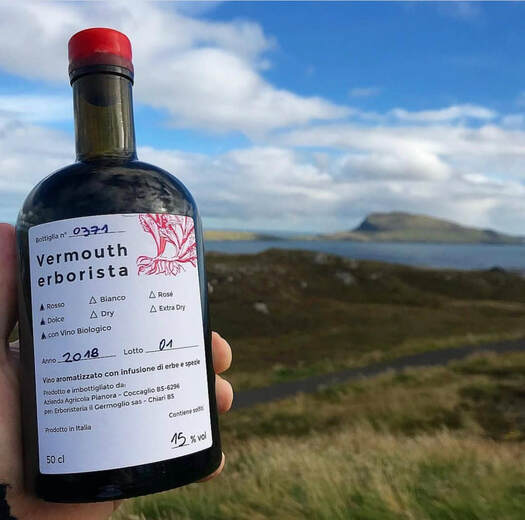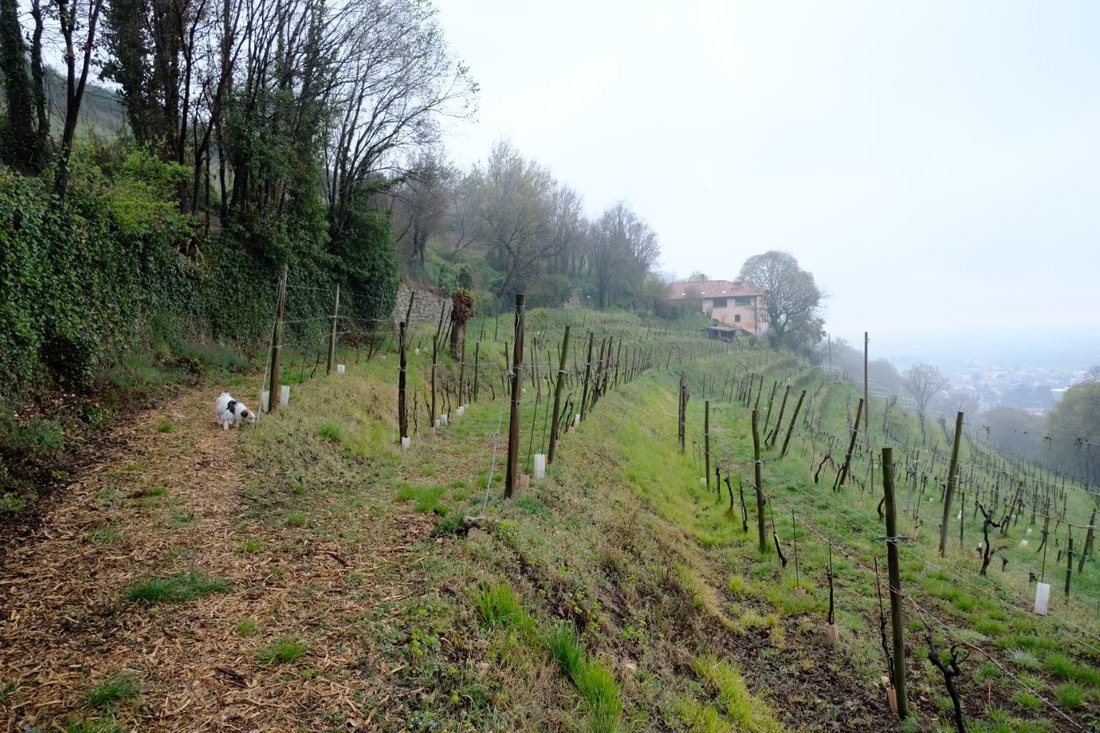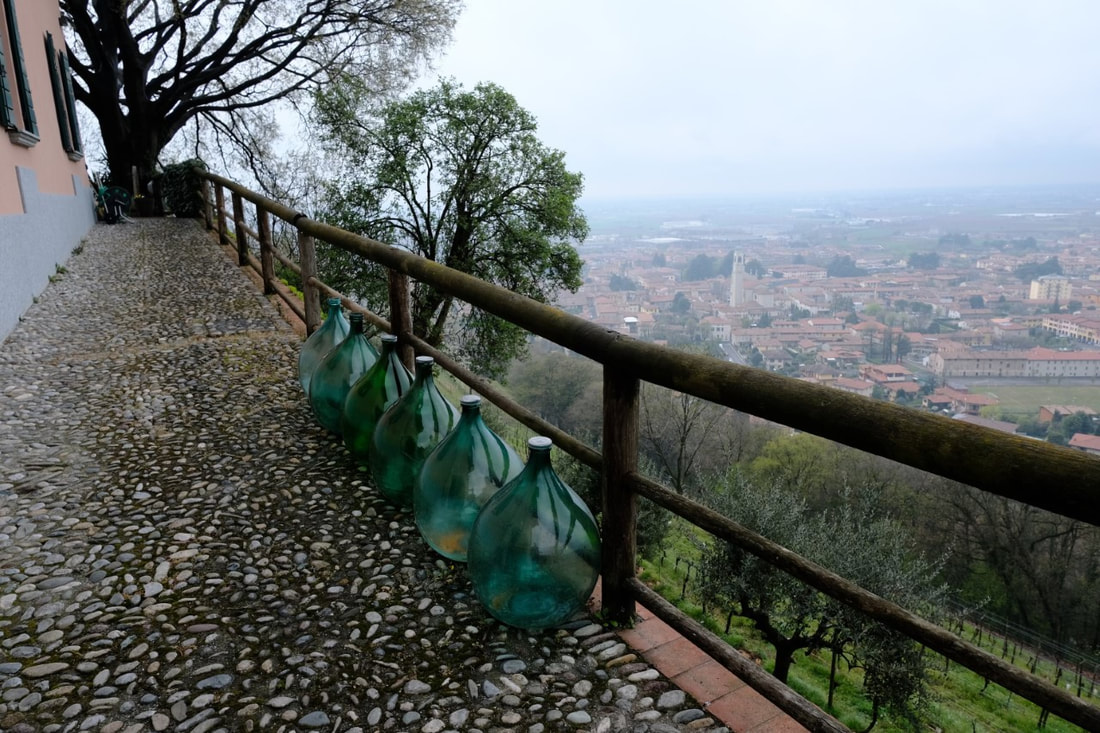Azienda Agricola Pianora, Coccaglio, Italy
Pianora, founded in 1986, is located on Montorfano, a hill of tectonic origin that marks the southern border of Franciacorta, characterized by the presence of the only steeply sloping terraced vineyards of this wine area.
The vineyard is made up of 2 hectares in all, of which 1.5 are vineyards and the remaining dedicated orchard and grove to promote biodiversity. The ancient terraces are located at 280 meters above sea level; they are very steep (slope approx. 50%), and with an excellent southern exposure.
The soil on which the vines grow is of tectonic origin with morainic surface remodeling: it is composed of pebbles of different sizes, conglomerate, quartz sand, red clay and marly limestone. In the vineyard there are some of the largest and most fascinating outcrops of conglomerate shoals in the area.
The vineyard is made up of 2 hectares in all, of which 1.5 are vineyards and the remaining dedicated orchard and grove to promote biodiversity. The ancient terraces are located at 280 meters above sea level; they are very steep (slope approx. 50%), and with an excellent southern exposure.
The soil on which the vines grow is of tectonic origin with morainic surface remodeling: it is composed of pebbles of different sizes, conglomerate, quartz sand, red clay and marly limestone. In the vineyard there are some of the largest and most fascinating outcrops of conglomerate shoals in the area.
Pianora, founded in 1986, is located on Montorfano, a hill of tectonic origin that marks the southern border of Franciacorta, characterized by the presence of the only steeply sloping terraced vineyards of this wine area.
The vineyard is made up of 2 hectares in all, of which 1.5 are vineyards and the remaining dedicated orchard and grove to promote biodiversity. The ancient terraces are located at 280 meters above sea level; they are very steep (slope approx. 50%), and with an excellent southern exposure.
The soil on which the vines grow is of tectonic origin with morainic surface remodeling: it is composed of pebbles of different sizes, conglomerate, quartz sand, red clay and marly limestone. In the vineyard there are some of the largest and most fascinating outcrops of conglomerate shoals in the area.
Wermut Erborista Formula XII: This comes from the base of certified organic wine from the Pianora sul Montorfano vineyard in Coccaglio (BS), enriched with slow infusions of carefully selected herbs and spices. This was born with the idea of enhancing a territory, that of Montorfano, using wines born from its land and selections of botanicals that find their place on its slopes, combined with others of exotic origin.
On the nose the main note is given by the Elderflower and the aromatic Sweet Flag. Three types of artemisie (wormwood), of which two are local, and barks of precious woods such as Citrine Sandalwood and China calissaia (quinine) give elegant bitter, persistent and constantly evolving notes. The brilliant reflections and the carmine red color are given by the cabernet sauvignon and merlot blend present in the infusion blend, not caramelized sugar (most red vermouth is a white wine base colored with caramelized sugar).
The blend of botanicals has been studied thanks to the advice of one of the pioneers of the herbalist world in Italy: Sergio Rossi of Erborista il Germoglio which boasts over 35 years of experience with plants, spices and infusions. There is no added alcohol, ready-made essences, chemical additives, artificial colorings, caramel or burnt sugar.
Erborista Aperitivo: The production philosophy is the same as wermut: no added alcohol, no food coloring, no burnt sugar or caramel. Only organic wine (Cabernet Sauvignon, carmenere, and Schiava) and infusion of dried officinal herbs and, in this case, fresh fruit from our orchard. The infusions are made separately, one for each plant at different extraction temperatures, and then combined to compose the recipe.
The sugar content is reduced as much as possible and the sweetening is done with some native plants such as elderberry flowers and linden leaves and flowers.
Wild chamomile and cherry and black cherries stand out in the infusion mixture. Slightly bitter notes are given by thyme, marjoram and elderberry roots. Production is only one batch per year when seasonal fruit is available. The best way of enjoy it is pure, cold or as a base for different cocktails
The vineyard is made up of 2 hectares in all, of which 1.5 are vineyards and the remaining dedicated orchard and grove to promote biodiversity. The ancient terraces are located at 280 meters above sea level; they are very steep (slope approx. 50%), and with an excellent southern exposure.
The soil on which the vines grow is of tectonic origin with morainic surface remodeling: it is composed of pebbles of different sizes, conglomerate, quartz sand, red clay and marly limestone. In the vineyard there are some of the largest and most fascinating outcrops of conglomerate shoals in the area.
Wermut Erborista Formula XII: This comes from the base of certified organic wine from the Pianora sul Montorfano vineyard in Coccaglio (BS), enriched with slow infusions of carefully selected herbs and spices. This was born with the idea of enhancing a territory, that of Montorfano, using wines born from its land and selections of botanicals that find their place on its slopes, combined with others of exotic origin.
On the nose the main note is given by the Elderflower and the aromatic Sweet Flag. Three types of artemisie (wormwood), of which two are local, and barks of precious woods such as Citrine Sandalwood and China calissaia (quinine) give elegant bitter, persistent and constantly evolving notes. The brilliant reflections and the carmine red color are given by the cabernet sauvignon and merlot blend present in the infusion blend, not caramelized sugar (most red vermouth is a white wine base colored with caramelized sugar).
The blend of botanicals has been studied thanks to the advice of one of the pioneers of the herbalist world in Italy: Sergio Rossi of Erborista il Germoglio which boasts over 35 years of experience with plants, spices and infusions. There is no added alcohol, ready-made essences, chemical additives, artificial colorings, caramel or burnt sugar.
Erborista Aperitivo: The production philosophy is the same as wermut: no added alcohol, no food coloring, no burnt sugar or caramel. Only organic wine (Cabernet Sauvignon, carmenere, and Schiava) and infusion of dried officinal herbs and, in this case, fresh fruit from our orchard. The infusions are made separately, one for each plant at different extraction temperatures, and then combined to compose the recipe.
The sugar content is reduced as much as possible and the sweetening is done with some native plants such as elderberry flowers and linden leaves and flowers.
Wild chamomile and cherry and black cherries stand out in the infusion mixture. Slightly bitter notes are given by thyme, marjoram and elderberry roots. Production is only one batch per year when seasonal fruit is available. The best way of enjoy it is pure, cold or as a base for different cocktails
Q & A with Matteo Efrem Rossi of Pianora
via email
translated from Italian to English
What is the difference between the Aperitivo and Erborista?
The line of aromatized wines Erborista consists of 3 recipes (Herbalist formula XII, herbalist Formula MIKE, and Herbalist Aperitif), all very different from each other in aromas and plants used for infusions.
The first recipe to have been developed is formula XII, is a meditation vermouth, very complex in aromas and characterized by very deep bitter notes. The protagonists of this recipe are the roots, berries, and sandalwood.
The MIKE recipe is dedicated to the world of mixologists. It is the most concentrated version in aromas and aromas, has herbaceous and balsamic notes given by mountain mint and eucalyptus, and a decidedly bitter and aromatic finish.
Herbalist aperitif instead is the only recipe that uses fresh fruit in infusions, has a marked sweetness given by elderflowers and linden leaves. Sweetness and acidity are the protagonists of this aperitif to be enjoyed cold
How and when are the cherries added for the aperitif?
To make the wines of the Erborista line we collect our grapes with the highest possible sugar content, usually in late October. Using alcohol to fortify the wine is forbidden to a winery (in Italy only distilleries can do it). Our desire has always been to make our products without processing done by others, so the only way we have to have an alcohol content useful to make our products is to reach 17 degrees alcohol exclusively through fermentation.
During the winter the wine produced rests, matures, and stabilizes. Only the following spring is it ready to be divided into small batches and be ready to be flavored with infusions.
Until now I have used fresh cherries and sour cherries, so the preparation of the herbalist aperitif always began in May. The fruit is harvested in our biodynamic orchard, the kernel is removed and then the slow infusions into the wine begin. For some time, I started experimenting with infusions with dried fruit and then used to give aroma to wine. The result is exceptional: with the right drying the flavors and sugars of the fruit are concentrated and are more incisive. This also allows me to have the necessary fruit all year round!
Does the base wine blend change vintage to vintage?
Absolutely.
The wine that we allocate to the Erborista line is mostly Merlot and some typical varieties of our hills. We use only the grapes that come from our small vineyard so the wine, from year to year, is different because it reflects the climatic characteristics of a particular year. Depending on the vintage and how the grapes ripen there may be variations in the blend. For the XII recipe in 2019 for example I used a large percentage of cabernet sauvignon that had matured excellently and gave further depth to the product
How long have you been making the aromatized wines?
For a long time, I started to get passionate about the world of aromatized wines (as a first profession I am an herbalist). moreover, on our hills for centuries wine has been used to extract the active ingredients of medicinal plants. It was one of the few ways that man had to preserve the properties of plants useful for his health. These products, however, were not very pleasant to the taste, very bitter, and difficult to drink.
More than the health properties of plants, I am interested in developing new tastes and focusing on the flavors and aromas of plants. I have always done small infusion experiments, but I started my first professional experiments in 2016
How did the collaboration with Sergio Rossi of Erborista il Germoglio begin?
Sergio is my father, also an herbalist. Since I was a child, he introduced me to the world of medicinal plants and, in the recipes of the Herbalist line, he helped me to select some plants with particular properties
translated from Italian to English
What is the difference between the Aperitivo and Erborista?
The line of aromatized wines Erborista consists of 3 recipes (Herbalist formula XII, herbalist Formula MIKE, and Herbalist Aperitif), all very different from each other in aromas and plants used for infusions.
The first recipe to have been developed is formula XII, is a meditation vermouth, very complex in aromas and characterized by very deep bitter notes. The protagonists of this recipe are the roots, berries, and sandalwood.
The MIKE recipe is dedicated to the world of mixologists. It is the most concentrated version in aromas and aromas, has herbaceous and balsamic notes given by mountain mint and eucalyptus, and a decidedly bitter and aromatic finish.
Herbalist aperitif instead is the only recipe that uses fresh fruit in infusions, has a marked sweetness given by elderflowers and linden leaves. Sweetness and acidity are the protagonists of this aperitif to be enjoyed cold
How and when are the cherries added for the aperitif?
To make the wines of the Erborista line we collect our grapes with the highest possible sugar content, usually in late October. Using alcohol to fortify the wine is forbidden to a winery (in Italy only distilleries can do it). Our desire has always been to make our products without processing done by others, so the only way we have to have an alcohol content useful to make our products is to reach 17 degrees alcohol exclusively through fermentation.
During the winter the wine produced rests, matures, and stabilizes. Only the following spring is it ready to be divided into small batches and be ready to be flavored with infusions.
Until now I have used fresh cherries and sour cherries, so the preparation of the herbalist aperitif always began in May. The fruit is harvested in our biodynamic orchard, the kernel is removed and then the slow infusions into the wine begin. For some time, I started experimenting with infusions with dried fruit and then used to give aroma to wine. The result is exceptional: with the right drying the flavors and sugars of the fruit are concentrated and are more incisive. This also allows me to have the necessary fruit all year round!
Does the base wine blend change vintage to vintage?
Absolutely.
The wine that we allocate to the Erborista line is mostly Merlot and some typical varieties of our hills. We use only the grapes that come from our small vineyard so the wine, from year to year, is different because it reflects the climatic characteristics of a particular year. Depending on the vintage and how the grapes ripen there may be variations in the blend. For the XII recipe in 2019 for example I used a large percentage of cabernet sauvignon that had matured excellently and gave further depth to the product
How long have you been making the aromatized wines?
For a long time, I started to get passionate about the world of aromatized wines (as a first profession I am an herbalist). moreover, on our hills for centuries wine has been used to extract the active ingredients of medicinal plants. It was one of the few ways that man had to preserve the properties of plants useful for his health. These products, however, were not very pleasant to the taste, very bitter, and difficult to drink.
More than the health properties of plants, I am interested in developing new tastes and focusing on the flavors and aromas of plants. I have always done small infusion experiments, but I started my first professional experiments in 2016
How did the collaboration with Sergio Rossi of Erborista il Germoglio begin?
Sergio is my father, also an herbalist. Since I was a child, he introduced me to the world of medicinal plants and, in the recipes of the Herbalist line, he helped me to select some plants with particular properties





